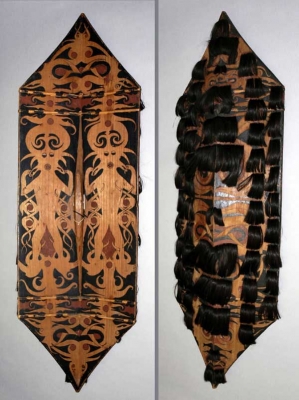Kenyah shield (1907.75.19)
 MalaysiaKenyah shield from Sarawak, Malaysia, Asia. Collected by H. L. Chittenden. Purchased by the Museum from him in 1907.
MalaysiaKenyah shield from Sarawak, Malaysia, Asia. Collected by H. L. Chittenden. Purchased by the Museum from him in 1907.
This type of wooden shield is known as a klebit bok and belongs to the Kenyah, an agriculturalist people indigenous to Borneo. The Kenyah consist of over 40 sub-groups that live in remote regions in Sarawak in the north (Malaysia) and Kalimantan in the centre and south (Indonesia).
It is painted on both sides with red and black designs and is richly decorated with clumps of human hair forced into the narrow cracks of the wood before being secured with fresh wax. The hair is allegedly from hunted heads and the name is derived from klebit, meaning 'shield' and bok, meaning 'hair', indicating that the identity of the object is bound up in the link between the shield and the hair.
Defining Gender
Like many peoples of Assam, Borneo, the Philippines, and Oceania, the Kenyah historically practised head-hunting raids. Raiding was their principal form of warfare, performed typically to seek revenge upon other groups for past raids, thefts and insults. However, heads were also required for the proper completion of lengthy burial rites, particularly so that mourning taboos could be lifted. As the benevolence of ancestors determined agricultural fertility and successful harvests, as well as the personal health of their descendants, so head-hunting was considered a vital part of a man's social responsibility. In turn, the fulfilment of that social responsibility determined his prestige, and the health and nourishment of his family.
Thus, this shield embodies the two-sided nature of head-hunting: The outer face of these shields bears the terrifying tusked features of a demonic creature similar to a Javanese Hindu rakshasa, ornamented with fringes of human hair taken from previous victims - all intended to terrify the opponent. The inside, however, generally depicts a pair of smiling, benevolent figures, representing the warrior's family and ancestors - those who gave him courage and who benefited from his acts of bravery. Consequently, head-hunting was viewed as a noble and pious activity, and the taken heads were viewed as the material evidence of a man's character and worth. Because of this, the heads were dried and kept in racks, each was known and addressed personally by name, and all were treated with great care and respect.





